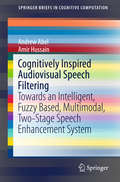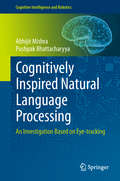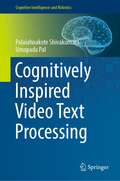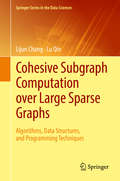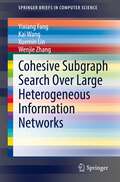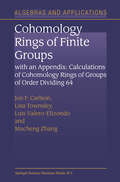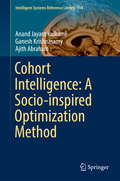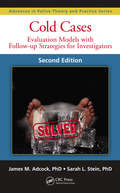- Table View
- List View
Cognitive Underwater Acoustic Networking Techniques (SpringerBriefs in Electrical and Computer Engineering)
by Dimitri Sotnik Michael Goetz Ivor NissenThis book summarizes the latest research on cognitive network-layer methods and smart adaptive physical-layer methods in underwater networks. Underwater communication requires extendable and delay-tolerant underwater acoustic networks capable of supporting multiple frequency bands, data rates and transmission ranges. The book also discusses a suitable foreground communication stack for mixed mobile/static networks, a technology that requires adaptive physical layer waveforms and cognitive network strategies with underlying cooperative and non-cooperative robust processes. The goal is to arrive at a universally applicable standard in the area of Underwater Internet-of-Things [ISO/IEC 30140, 30142, 30143]. The book is the second spin-off of the research project RACUN, after the first RACUN-book "Underwater Acoustic Networking Techniques" (https://link.springer.com/book/10.1007%2F978-3-642-25224-2)
Cognitive Vehicular Networks
by Anna Maria Vegni Dharma P. AgrawalA comprehensive text on both current and emerging areas of cognitive vehicular networks, this book focuses on a new class of mobile ad hoc networks. It uses a pedagogical approach utilizing cognitive aspects applied to vehicular environments and comprises contributions from well-known and high profile researchers in their respective specialties. The book provides significant technical and practical insights on different perspectives, starting from a basic background on cognitive radio, interrelated technologies, application to vehicular networks, technical challenges, and future trends.
Cognitive Vehicular Networks
by Anna Maria Vegni Dharma P. AgrawalA comprehensive text on both current and emerging areas of cognitive vehicular networks, this book focuses on a new class of mobile ad hoc networks. It uses a pedagogical approach utilizing cognitive aspects applied to vehicular environments and comprises contributions from well-known and high profile researchers in their respective specialties. The book provides significant technical and practical insights on different perspectives, starting from a basic background on cognitive radio, interrelated technologies, application to vehicular networks, technical challenges, and future trends.
Cognitive Virtual Assistants Using Google Dialogflow: Develop Complex Cognitive Bots Using the Google Dialogflow Platform
by Navin Sabharwal Amit AgrawalFollow a step-by-step, hands-on approach to building production-ready enterprise cognitive virtual assistants using Google Dialogflow. This book provides an overview of the various cognitive technology choices available and takes a deep dive into cognitive virtual agents for handling complex real-life use cases in various industries such as travel and weather. You’ll delve deeper into the advanced features of cognitive virtual assistants implementing features such as input/output context, follow-up intents, actions and parameters, and handling complex multiple intents. You’ll learn how to integrate with third-party messaging platforms by integrating your cognitive bot with Facebook messenger. You’ll also integrate with third-party APIs to enrich your cognitive bots using webhooks. Cognitive Virtual Assistants Using Google Dialogflow takes the complexity out of the cognitive platform and provides rich guidance which you can use when developing your own cognitive bots. The book covers Google Dialogflow in-depth and starts with the basics, serving as a hands-on guide for developers who are starting out on their journey with Google Dialogflow. All the code presented in the book will be available in the form of scripts and configuration files, which allows you to try out the examples and extend them in interesting ways.What You Will LearnDevelop cognitive bots with Google Dialogflow technologyUse advanced features to handle complex conversation scenariosEnrich the bot’s conversations by understanding the sentiment of the userSee best practices for developing cognitive botsEnhance a cognitive bot by integrating with third-party services Who This Book Is For AI and ML developers.
Cognitive Virtual Network Operator Games (SpringerBriefs in Computer Science)
by Lingjie Duan Jianwei Huang Biying ShouThis SpringerBrief provides an overview of cognitive mobile virtual network operator’s (C-MVNO) decisions under investment flexibility, supply uncertainty, and market competition in cognitive radio networks. This is a new research area at the nexus of cognitive radio engineering and microeconomics. The authors focus on an operator’s joint spectrum investment and service pricing decisions. The readers will learn how to tradeoff the two flexible investment choices (dynamic spectrum leasing and spectrum sensing) under supply uncertainty. Furthermore, if there is more than one operator, we present analysis of the competition among operators in obtaining spectrum and pricing services to attract users. The brief is designed for professionals working with C-MVNOs. Succinct and practical, it will assist them in making optimal investments and pricing decisions. It will also be of interest to researchers.
Cognitive Vision: 4th International Workshop, ICVW 2008, Santorini, Greece, May 12, 2008, Revised Selected Papers (Lecture Notes in Computer Science #5329)
by Markus VinczeWeareverypleasedtopresenttheproceedingsofthe4thInternationalCognitive Vision Workshop,held as part of the 6th InternationalConference on Computer Vision Systems on Santorini,Greeceduring May12–15,2008.The aim of ICVW 2008 was to document the progress of the relatively young ?eld of cognitive computer vision, bringing together researchers working and interested in this ?eld and giving them a platform to discuss the results of the di?erent European cognitive vision projects as well as international projects in this area. Original research papers were solicited in all aspects of cognitive vision, targeting the following areas in particular: – Memory: The coupling between visual perception, tasks, knowledge and the visualsystemrequiresmemory.Issuesthatareofspecialimportanceforin- grating memory into vision systems include: how to manage representations with limited resources;modelfor attention;integrationofinformationacross representations and time. – Learning and Adaptation: A system whose goal is that of interacting with the real world must be capable of learning from experience and adapting to unexpected changes. Also, there is a need for integration of multiple - sual features to enable generation of stable hypotheses, and for methods for combination of cues in the presence of uncertainty. – Categorization: Research has in particular focused on recall of speci?c - ject instances, events and actions. Whereas recently some progress has been achieved in systems that allow limited recognition of object classes, events and scenes across visual appearance, new methods are needed to enable abstractions and e?ective categorization across variations in color, surface markings, geometry, temporal scenes, context and tasks.
Cognitive Vision Systems: Sampling the Spectrum of Approaches (Lecture Notes in Computer Science #3948)
by Henrik I. Christensen Hans-Hellmut NagelThis volume is a post-event proceedings volume and contains selected papers based on the presentations given, and the lively discussions that ensued, during a seminar held in Dagstuhl Castle, Germany, in October 2003. Co-sponsored by ECVision, the cognitive vision network of excellence, it was organized to further strengthen cooperation between research groups from different countries working in the field of cognitive vision systems.
Cognitive Wireless Communication Networks
by Ekram Hossain Vijay K. BhargavaThis book provides a unified view on the state-of-the-art of cognitive radio technology. It includes a set of research and survey articles featuring the recent advances in theory and applications of cognitive radio technology for the next generation (e.g., fourth generation) wireless communication networks. The contributed articles cover both the theoretical concepts (e.g., information-theoretic analysis) and system-level implementation issues.
Cognitive Wireless Networks (SpringerBriefs in Electrical and Computer Engineering)
by Zhiyong Feng Qixun Zhang Ping ZhangThis brief examines the current research in cognitive wireless networks (CWNs). Along with a review of challenges in CWNs, this brief presents novel theoretical studies and architecture models for CWNs, advances in the cognitive information awareness and delivery, and intelligent resource management technologies. The brief presents the motivations and concepts of CWNs, including theoretical studies of temporal and geographic distribution entropy as well as cognitive information metrics. A new architecture model of CWNs is proposed with theoretical, functional and deployment architectures supporting cognitive information flow and resource flow. Key technologies are identified to achieve the efficient cognitive information awareness and delivery. The brief concludes by validating the effectiveness of proposed theories and technologies using the CWNs testbed and discussing the importance of standardization practices. The context and analysis provided by this text are ideal for researchers and practitioners interested in wireless networks and cognitive information. Cognitive Wireless Networks is also valuable for advanced-level students studying resource management and networking.
Cognitive Wireless Networks: Concepts, Methodologies and Visions Inspiring the Age of Enlightenment of Wireless Communications
by Frank H. P. Fitzek Marcos D. KatzThis book advocates the idea of breaking up the cellular communication architecture by introducing cooperative strategies among wireless devices through cognitive wireless networking. It details the cooperative and cognitive aspects for future wireless communication networks. Coverage includes social and biological inspired behavior applied to wireless networks, peer-to-peer networking, cooperative networks, and spectrum sensing and management.
Cognitive Wireless Networks Using the CSS Technology (Lecture Notes in Electrical Engineering #384)
by Meiling Li Anhong Wang Jeng-Shyang PanThe aim of this book is to provide some useful methods to improve the spectrum sensing performance in a systematic way, and point out an effective method for the application of cognitive radio technology in wireless communications. The book gives a a state-of-the-art survey and proposes some new cooperative spectrum sensing (CSS) methods attempting to achieve better performance. For each CSS, the main idea and corresponding algorithm design are elaborated in detail. This book covers the fundamental concepts and the core technologies of CSS, especially its latest developments. Each chapter is presented in a self-sufficient and independent way so that the reader can select the chapters interesting to them. The methodologies are described in detail so that the readers can repeat the corresponding experiments easily. It will be a useful book for researchers helping them to understand the classifications of CSS, inspiring new ideas about the novel CSS technology for CR, and learning new ideas from the current status of CSS. For engineers, it will be a good guidebook to develop practical applications for CSS.
Cognitively Inspired Audiovisual Speech Filtering: Towards an Intelligent, Fuzzy Based, Multimodal, Two-Stage Speech Enhancement System (SpringerBriefs in Cognitive Computation #5)
by Andrew Abel Amir HussainThis book presents a summary of the cognitively inspired basis behind multimodal speech enhancement, covering the relationship between audio and visual modalities in speech, as well as recent research into audiovisual speech correlation. A number of audiovisual speech filtering approaches that make use of this relationship are also discussed. A novel multimodal speech enhancement system, making use of both visual and audio information to filter speech, is presented, and this book explores the extension of this system with the use of fuzzy logic to demonstrate an initial implementation of an autonomous, adaptive, and context aware multimodal system. This work also discusses the challenges presented with regard to testing such a system, the limitations with many current audiovisual speech corpora, and discusses a suitable approach towards development of a corpus designed to test this novel, cognitively inspired, speech filtering system.
Cognitively Inspired Natural Language Processing: An Investigation Based on Eye-tracking (Cognitive Intelligence and Robotics)
by Abhijit Mishra Pushpak BhattacharyyaThis book shows ways of augmenting the capabilities of Natural Language Processing (NLP) systems by means of cognitive-mode language processing. The authors employ eye-tracking technology to record and analyze shallow cognitive information in the form of gaze patterns of readers/annotators who perform language processing tasks. The insights gained from such measures are subsequently translated into systems that help us (1) assess the actual cognitive load in text annotation, with resulting increase in human text-annotation efficiency, and (2) extract cognitive features that, when added to traditional features, can improve the accuracy of text classifiers. In sum, the authors’ work successfully demonstrates that cognitive information gleaned from human eye-movement data can benefit modern NLP. Currently available Natural Language Processing (NLP) systems are weak AI systems: they seek to capture the functionality of human language processing, without worrying about how this processing is realized in human beings’ hardware. In other words, these systems are oblivious to the actual cognitive processes involved in human language processing. This ignorance, however, is NOT bliss! The accuracy figures of all non-toy NLP systems saturate beyond a certain point, making it abundantly clear that “something different should be done.”
Cognitively Inspired Video Text Processing (Cognitive Intelligence and Robotics)
by Umapada Pal Palaiahnakote ShivakumaraAs technologies are fast advancing, the importance of text detection and recognition is receiving special attention from the researchers. Thus, one can see several real-time applications of video text processing which requires cognitive-based methods to find a solution. The main applications are (1) retrieving and indexing video based on semantic of the content of the video, (2) machine translation to assist foreigners, (3) assisting blind people to walk on the road freely without aid, (4) automatic vehicle driving, (5) license plate tracing to catch vehicles which violate the traffic signals, (6) monitoring the images posted on social media based on text and content of the images, (7) identifying the location based on the address of the street and shops, etc., (8) tracing players in the sports based on the jersey/bib number or text, and (9) in the same way, tracing the bib number in case of marathon and other events. For the above-mentioned applications, text detection and recognition in video and natural scene images is an integral part of the system.
Coherence: In Signal Processing and Machine Learning
by David Ramírez Ignacio Santamaría Louis ScharfThis book organizes principles and methods of signal processing and machine learning into the framework of coherence. The book contains a wealth of classical and modern methods of inference, some reported here for the first time. General results are applied to problems in communications, cognitive radio, passive and active radar and sonar, multi-sensor array processing, spectrum analysis, hyperspectral imaging, subspace clustering, and related. The reader will find new results for model fitting; for dimension reduction in models and ambient spaces; for detection, estimation, and space-time series analysis; for subspace averaging; and for uncertainty quantification. Throughout, the transformation invariances of statistics are clarified, geometries are illuminated, and null distributions are given where tractable. Stochastic representations are emphasized, as these are central to Monte Carlo simulations. The appendices contain a comprehensive account of matrix theory, the SVD, the multivariate normal distribution, and many of the important distributions for coherence statistics. The book begins with a review of classical results in the physical and engineering sciences where coherence plays a fundamental role. Then least squares theory and the theory of minimum mean-squared error estimation are developed, with special attention paid to statistics that may be interpreted as coherence statistics. A chapter on classical hypothesis tests for covariance structure introduces the next three chapters on matched and adaptive subspace detectors. These detectors are derived from likelihood reasoning, but it is their geometries and invariances that qualify them as coherence statistics. A chapter on independence testing in space-time data sets leads to a definition of broadband coherence, and contains novel applications to cognitive radio and the analysis of cyclostationarity. The chapter on subspace averaging reviews basic results and derives an order-fitting rule for determining the dimension of an average subspace. These results are used to enumerate sources of acoustic and electromagnetic radiation and to cluster subspaces into similarity classes. The chapter on performance bounds and uncertainty quantification emphasizes the geometry of the Cramèr-Rao bound and its related information geometry.
Coherent Atomic Manipulation and Cooling: Interferometric Laser Cooling and Composite Pulses for Atom Interferometry (Springer Theses)
by Alexander J. DunningThis work unites the concepts of laser cooling and matter-wave interferometry to develop an interferometric laser cooling technique in an experimental system of cold rubidium atoms. Serving as an introduction to graduate level coherent optical atomic manipulation, the thesis describes the theory of stimulated Raman transitions and atom interferometry, along with the experimental methods for preparing and manipulating cold atoms, before building on these foundations to explore tailored optical pulse sequences and novel atomic cooling techniques.Interferometric cooling, originally proposed by Weitz and Hänsch in 2000, is based upon the coherent broadband laser pulses of Ramsey interferometry and in principle allows laser cooling of atomic and molecular species outside the scope of traditional Doppler laser cooling. On the path toward cooling, composite pulses – quantum error correction methods, developed by chemists to mitigate the effects of in homogeneities in NMR spectroscopy – are investigated with a view to improving the performance of atom interferometers.
Coherent Evolution in Noisy Environments (Lecture Notes in Physics #611)
by Andreas Buchleitner Klaus HornbergerIn the last two decades extraordinary progress in the experimental handling of single quantum objects has spurred theoretical research into investigating the coupling between quantum systems and their environment. Decoherence, the gradual deterioration of entanglement due to dissipation and noise fed to the system by the environment, has emerged as a central concept. The present set of lectures is intended as a high-level, but self-contained, introduction into the fields of quantum noise and dissipation.In particular their influence on decoherence and applications pertaining to quantum information and quantum communication are studied, leading the nonspecialist researchers and the advanced students gradually to the forefront of research.
Coherent States, Wavelets and Their Generalizations (Graduate Texts in Contemporary Physics)
by Syed T. Ali J-P Antoine Jean-Perre GazeauA survey of the theory of coherent states, wavelets, and some of their generalizations, emphasizing mathematical structures. Starting from the standard theory of coherent states over Lie groups, the authors generalize the formalism by associating coherent states to group representations that are square integrable over a homogeneous space; a further step allows the group context to be dispensed with altogether. The unified background makes transparent otherwise obscure properties of wavelets and of coherent states. Many concrete examples, such as semisimple Lie groups, the relativity group, and several kinds of wavelets, are discussed in detail. The book concludes with physical applications, centering on the quantum measurement problem and the quantum-classical transition. Intended as an introduction to current research for graduate students and others entering the field, the mathematical discussion is self- contained. With its extensive references to the research literature, the book will also be a useful compendium of recent results for physicists and mathematicians already active in the field.
Coherent States, Wavelets, and Their Generalizations (Theoretical and Mathematical Physics)
by Syed Twareque Ali Jean-Pierre Antoine Jean-Pierre GazeauThis second edition is fully updated, covering in particular new types of coherent states (the so-called Gazeau-Klauder coherent states, nonlinear coherent states, squeezed states, as used now routinely in quantum optics) and various generalizations of wavelets (wavelets on manifolds, curvelets, shearlets, etc.). In addition, it contains a new chapter on coherent state quantization and the related probabilistic aspects. As a survey of the theory of coherent states, wavelets, and some of their generalizations, it emphasizes mathematical principles, subsuming the theories of both wavelets and coherent states into a single analytic structure. The approach allows the user to take a classical-like view of quantum states in physics.Starting from the standard theory of coherent states over Lie groups, the authors generalize the formalism by associating coherent states to group representations that are square integrable over a homogeneous space; a further step allows one to dispense with the group context altogether. In this context, wavelets can be generated from coherent states of the affine group of the real line, and higher-dimensional wavelets arise from coherent states of other groups. The unified background makes transparent an entire range of properties of wavelets and coherent states. Many concrete examples, such as coherent states from semisimple Lie groups, Gazeau-Klauder coherent states, coherent states for the relativity groups, and several kinds of wavelets, are discussed in detail. The book concludes with a palette of potential applications, from the quantum physically oriented, like the quantum-classical transition or the construction of adequate states in quantum information, to the most innovative techniques to be used in data processing.Intended as an introduction to current research for graduate students and others entering the field, the mathematical discussion is self-contained. With its extensive references to the research literature, the first edition of the book is already a proven compendium for physicists and mathematicians active in the field, and with full coverage of the latest theory and results the revised second edition is even more valuable.
Coherent Structures in Complex Systems: Selected Papers of the XVII Sitges Conference on Statistical Mechanics Held at Sitges, Barcelona, Spain, 5–9 June 2000. Preliminary Version (Lecture Notes in Physics #567)
by D. Reguera L. L. Bonilla J. M. RubiA rich variety of real-life physical problems which are still poorly understood are of a nonlinear nature. Examples include turbulence, granular flows, detonations and flame propagation, fracture dynamics, and a wealth of new biological and chemical phenomena which are being discovered. Particularly interesting among the manifestations of nonlinearity are coherent structures. This book contains reviews and contributions reporting on the state of the art regarding the role of coherent structures and patterns in nonlinear science.
Cohesive Subgraph Computation over Large Sparse Graphs: Algorithms, Data Structures, and Programming Techniques (Springer Series in the Data Sciences)
by Lijun Chang Lu QinThis book is considered the first extended survey on algorithms and techniques for efficient cohesive subgraph computation. With rapid development of information technology, huge volumes of graph data are accumulated. An availability of rich graph data not only brings great opportunities for realizing big values of data to serve key applications, but also brings great challenges in computation. Using a consistent terminology, the book gives an excellent introduction to the models and algorithms for the problem of cohesive subgraph computation. The materials of this book are well organized from introductory content to more advanced topics while also providing well-designed source codes for most algorithms described in the book. This is a timely book for researchers who are interested in this topic and efficient data structure design for large sparse graph processing. It is also a guideline book for new researchers to get to know the area of cohesive subgraph computation.
Cohesive Subgraph Search Over Large Heterogeneous Information Networks (SpringerBriefs in Computer Science)
by Wenjie Zhang Xuemin Lin Kai Wang Yixiang FangThis SpringerBrief provides the first systematic review of the existing works of cohesive subgraph search (CSS) over large heterogeneous information networks (HINs). It also covers the research breakthroughs of this area, including models, algorithms and comparison studies in recent years. This SpringerBrief offers a list of promising future research directions of performing CSS over large HINs.The authors first classify the existing works of CSS over HINs according to the classic cohesiveness metrics such as core, truss, clique, connectivity, density, etc., and then extensively review the specific models and their corresponding search solutions in each group. Note that since the bipartite network is a special case of HINs, all the models developed for general HINs can be directly applied to bipartite networks, but the models customized for bipartite networks may not be easily extended for other general HINs due to their restricted settings. The authors also analyze and compare these cohesive subgraph models (CSMs) and solutions systematically. Specifically, the authors compare different groups of CSMs and analyze both their similarities and differences, from multiple perspectives such as cohesiveness constraints, shared properties, and computational efficiency. Then, for the CSMs in each group, the authors further analyze and compare their model properties and high-level algorithm ideas.This SpringerBrief targets researchers, professors, engineers and graduate students, who are working in the areas of graph data management and graph mining. Undergraduate students who are majoring in computer science, databases, data and knowledge engineering, and data science will also want to read this SpringerBrief.
Cohomology Rings of Finite Groups: With an Appendix: Calculations of Cohomology Rings of Groups of Order Dividing 64 (Algebra and Applications #3)
by Jon F. Carlson L. Townsley Luís Valero-Elizondo Mucheng ZhangGroup cohomology has a rich history that goes back a century or more. Its origins are rooted in investigations of group theory and num ber theory, and it grew into an integral component of algebraic topology. In the last thirty years, group cohomology has developed a powerful con nection with finite group representations. Unlike the early applications which were primarily concerned with cohomology in low degrees, the in teractions with representation theory involve cohomology rings and the geometry of spectra over these rings. It is this connection to represen tation theory that we take as our primary motivation for this book. The book consists of two separate pieces. Chronologically, the first part was the computer calculations of the mod-2 cohomology rings of the groups whose orders divide 64. The ideas and the programs for the calculations were developed over the last 10 years. Several new features were added over the course of that time. We had originally planned to include only a brief introduction to the calculations. However, we were persuaded to produce a more substantial text that would include in greater detail the concepts that are the subject of the calculations and are the source of some of the motivating conjectures for the com putations. We have gathered together many of the results and ideas that are the focus of the calculations from throughout the mathematical literature.
Cohort Intelligence: A Socio-inspired Optimization Method (Intelligent Systems Reference Library #114)
by Anand Jayant Kulkarni Ganesh Krishnasamy Ajith AbrahamThis Volume discusses the underlying principles and analysis of the different concepts associated with an emerging socio-inspired optimization tool referred to as Cohort Intelligence (CI). CI algorithms have been coded in Matlab and are freely available from the link provided inside the book. The book demonstrates the ability of CI methodology for solving combinatorial problems such as Traveling Salesman Problem and Knapsack Problem in addition to real world applications from the healthcare, inventory, supply chain optimization and Cross-Border transportation. The inherent ability of handling constraints based on probability distribution is also revealed and proved using these problems.
Cold Cases: Evaluation Models with Follow-up Strategies for Investigators, Second Edition
by James M. Adcock Sarah L. SteinBecause the investigation of cold cases is usually an arduous and time-consuming task, most law enforcement agencies in the United States are not able to dedicate the resources necessary to support the cold case investigation process. However, when those cases are fully pursued and prosecuted, they often result in convictions and lengthy prison ter










